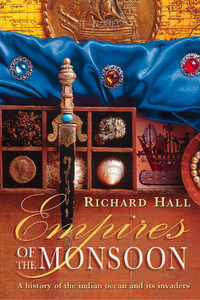A History of the Indian Oceanand its Invaders
RICHARD HALL
William Collins
An Imprint of HarperCollinsPublishers 1 London Bridge Street London SE1 9GF
www.harpercollins.co.uk
First published in Great Britain by HarperCollinsPublishers 1996
Copyright © Richard Hall 1996
Part title decoration from âThe Fleet of Vasco da Gamaâ illustrated in The Portuguese in India, Vol. 1, by Frederick Danvers
Richard Hall asserts the moral right to be identified as the author of this work
A catalogue record for this book is available from the British Library
All rights reserved under International and Pan-American Copyright Conventions. By payment of the required fees, you have been granted the nonexclusive, nontransferable right to access and read the text of this e-book on-screen. No part of this text may be reproduced, transmitted, downloaded, decompiled, reverse-engineered, or stored in or introduced into any information storage and retrieval system, in any form or by any means, whether electronic or mechanical, now known or hereinafter invented, without the express written permission of HarperCollins e-books.
HarperCollinsPublishers has made every reasonable effort to ensure that any picture content and written content in this ebook has been included or removed in accordance with the contractual and technological constraints in operation at the time of publication.
Source ISBN: 9780006380832
Ebook Edition © APRIL 2016 ISBN: 9780007547043 Version: 2018â10â09
Dedicated to the memory of Harry A. Logan Jr of Warren, Pennsylvania
Turn a map of the world upside down and the Indian Ocean can be seen as a vast, irregularly-shaped bowl, bounded by the shorelines of Africa and Asia, the islands of Indonesia, and the coast of Western Australia.>1 Unlike the Atlantic and Pacific, merging at their extremes into the polar seas, this is an entirely tropical ocean; to mention it calls up a vision of palm-fringed islands and lagoons where rainbow-hued fish dart amid the coral. That is the tourist-brochure image, but behind it lies the Indian Ocean of history â a centre of human progress, a great arena in which many races have mingled, fought and traded for thousands of years.
The earliest civilizations, in Egypt and the valley of the Tigris and Euphrates, had direct access to the Indian Ocean by way of the Red Sea and the Persian Gulf. At the hub, stretching towards the equator, lay the Indian sub-continent, itself the site of ancient cultures in the Indus valley. Since long before the time of Alexander the Great, travellers had brought back tales of the rich and voluptuous East. The emperor Trajan, arriving triumphantly at the Persian Gulf in A.D. 116, and watching mariners set sail for India, had mourned that he was too old to make the voyage and gaze upon its wonders.








